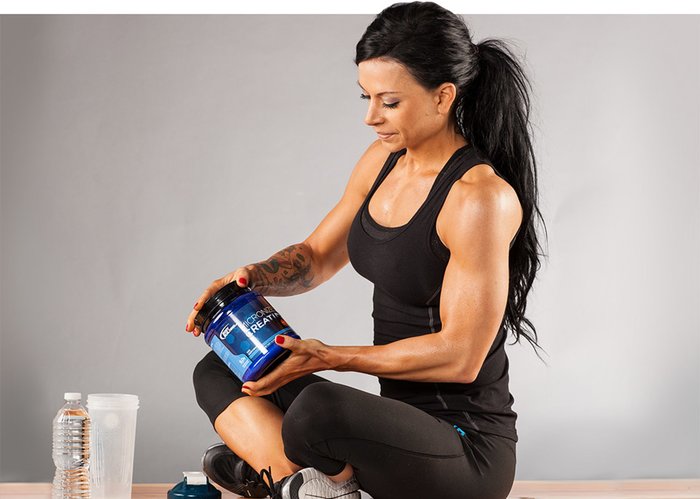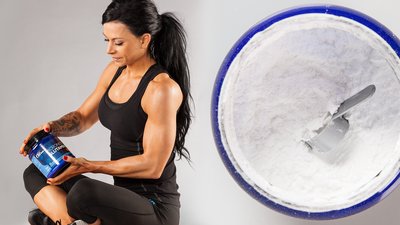Creatine is one of the most widely used supplements for bodybuilding and strength training. The majority of studies focusing on creatine supplementation have demonstrated significant increases in muscular strength and size, as well as improved body composition. Yet despite creatine's growing popularity, many people remain skeptical of its benefits.
You may be one of the unlucky few who are "nonresponders" to creatine. A nonresponder is an individual who currently supplements with creatine but experiences no noticeable improvements in strength, muscle mass, or performance.
But before jumping to the conclusion that creatine doesn't work, or doesn't work for you, consider whether you're using it correctly. In many cases, there's some degree of "user error."
Are you guilty of making these mistakes when supplementing with creatine?
Mistake 1: You Expect Your Pre-workout To Cover It
With all of the positive research supporting the use of creatine, it's now being added to other products, like pre-workouts. But if you rely on your pre-workout to deliver your daily dose of creatine, you'll likely come up short. Although most pre-workouts contain creatine, many (if not all) underdose the ingredient. Taking only 1-2 grams of creatine in your pre-workout is hardly enough to see any benefit—the suggested dose is 5 grams. If you don't take your pre-workout on a daily basis, you're even more likely to miss out on gains.
The easiest fix: Buy a tub of creatine. It's cheap, and because it comes unflavored, you can add it to any drink you make. To take full advantage of the benefits creatine has to offer, you need to saturate your cells with the substrate. There are two ways to do this:
- Start with a loading protocol: 20 grams of creatine a day divided into four equal doses over a period of 5-7 days, followed by a lower-dose maintenance phase of 5 grams daily. This is the quickest way to top off creatine stores—it takes only about a week—but some people complain that it leaves them feeling a little bloated because of the increase in water intake.
- To avoid any short-term weight gain or GI discomfort, use a lower-dose protocol of 5 grams daily. It'll take a little longer to maximize your creatine stores—about four weeks—but you're less likely to experience weight gain or bloating.
Mistake 2: You Have A Wandering Eye
Creatine's benefits are well-known, but which form is better? Should you pay a little more for creatine nitrate or creatine HCL, which often come with "no bloating, no loading" promises? Or can the tried-and-true creatine monohydrate deliver the results you're looking for?
My advice is to keep it simple: Do one or the other. Just don't try to do a little of both at the same time! It's too easy to get caught in a trap where you're using not-quite-optimal dosages and missing out on the benefits of loading.
Personally, I continue to recommend creatine monohydrate, and I don't expect to change my tune. Hundreds of research studies showing creatine's positive effects on increasing muscle size, strength, and power have all been done using creatine monohydrate, and the dosage protocol couldn't be simpler.
Can you have success with other variations? Sure. But make sure you take it consistently, at proper dosages, and for a long enough period to give it a chance!

Mistake 3: You Cycle Off It
Most of us consume protein powders because we either: A) Don't get enough protein in during the day through whole foods, or B) Find protein supplements a convenient (and sometimes cheaper) way to reach our daily macro goal.
Creatine is no different. While your body is capable of producing creatine on its own, it also excretes about 2 grams a day. Diet and supplementation can help you optimize creatine stores. Sure, you could rely on food to reach your creatine intake, but you'd have to consume 2-3 pounds of raw meat or fish to get the same amount of creatine as supplementing with a teaspoon of creatine monohydrate. Supplementation is also much cheaper and easier.
If you miss a dose here or there, don't sweat it. But taking an extended break from creatine can cause your creatine stores to decrease, and your gym performance will likely suffer.
Mistake 4: You Do The Wrong Kinds Of Workouts
Creatine is best known for its ability to improve performance in strength and speed. If your training is more focused around endurance work or steady-state cardio, you may not notice any benefits.
Your body has three systems responsible for producing energy (in the form of ATP). The energy system your body primarily relies on during resistance training and other short-duration activities like sprinting is the ATP-PCr system. Here, creatine phosphate is readily available to your cells and rapidly produces ATP. Although this system can produce energy at a very fast rate, the limited stores of creatine phosphate will supply energy for only about 10-15 seconds, and it can take anywhere from 3-5 minutes to replenish those stores.

While your body is capable of producing creatine on its own, it also excretes about 2 grams a day. Diet and supplementation can help you optimize creatine stores.
The benefit to supplementing with creatine is that it can increase resting concentrations of creatine phosphate, allowing you to continue short-term, high-intensity activity for a longer period. Over time, this can translate into a few extra reps or intervals being performed before fatigue sets in.
Because moderate-intensity, endurance-based workouts don't rely on the ATP-PCr system, you're not likely to see a significant change in performance with supplementation. Resistance-based workouts using a rep range of 3-12, or other anaerobic training using working intervals of 10-15 seconds long, will best showcase the benefits of creatine.
Mistake 5: You Expect Creatine To Do All The Work For You
As much as I like creatine as a credible performance-enhancing supplement, I'm not going to sit here and tell you it's a miracle worker. Supplementing with creatine while sitting on your butt all day won't magically increase your strength or size, and taking the occasional dose won't help you set a new PR for squats.
Most people expect immediate and profound effects when they start taking creatine. In reality, it takes awhile to fully top off creatine stores in your muscle cells. Even after this, you're not going to get a "holy crap, I'm on creatine" moment. What you will see is a gradual increase in your work capacity, which means a few extra reps, a few extra sets, and ultimately, a greater total training volume. All of this contributes to improvements in body composition, strength, and performance over time.

